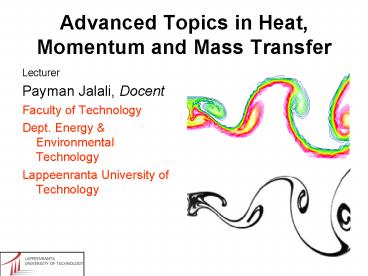Advanced Topics in Heat, Momentum and Mass Transfer - PowerPoint PPT Presentation
1 / 16
Title:
Advanced Topics in Heat, Momentum and Mass Transfer
Description:
We change the velocity variable in equations to vorticity, which is defined as: ... Solve the vorticity transport equation for at each interior grid point at time t ... – PowerPoint PPT presentation
Number of Views:86
Avg rating:3.0/5.0
Title: Advanced Topics in Heat, Momentum and Mass Transfer
1
Advanced Topics in Heat, Momentum and Mass
Transfer
- Lecturer
- Payman Jalali, Docent
- Faculty of Technology
- Dept. Energy Environmental Technology
- Lappeenranta University of Technology
2
In Cartesian coordinates, and two-dimensional
geometries we have the following Navier-Stokes
equations for incompressible fluid flows
Continuity (consevation of mass)
x-momentum (consevation of momentum)
y-momentum (consevation of momentum)
Energy (consevation of thermal energy)
3
Vorticity-Stream Function Approach Very popular
method for 2D incompressible NS equations. We
change the velocity variable in equations to
vorticity, which is defined as
The stream function in 2D is defined by the
following equations
4
Using this approach, we have separated the mixed
elliptic-parabolic NS equations into one
parabolic (the vorticity transport equation) and
one elliptic (the Poisson equation) equation.
- These equations are normally solved using a
time-marching procedure which is described by the
following steps - Give initial values for ? and ? at time t0.
- Solve the vorticity transport equation for ? at
each interior grid point at time t?t. - Find new ? values at all points by solving the
Poisson equation using new values of ? at
interior points from step 2. - Calculate velocity components from u?y and
v-?x. - Determine boundary values of ? using ? and ?
values at interior points. - Return to step 2 if the solution is not converged.
5
This procedure requires that appropriate
expressions for ? and ? be specified at the
boundaries. The stability and accuracy of the
solution depends on these boundary conditions. At
the wall surface, ? is a constant and usually 0.
To find ? at the surface we use the Taylor
expansion of ? about the wall point (i,1)
6
One of the test problems is the cavity problem as
shown below
7
- Give initial values for ? and ? (and u,v) at time
t0. - Solve the vorticity transport equation for ? at
each interior grid point at time t?t. This
equation can be solved using different methods.
For example, FTCS (forward-time and
centered-space) method is an explicit, one-step
method with first-order accuracy and the
truncation error is in the order of ?t and ?x2.
8
3) Find new ? values at all points by solving the
Poisson equation using new values of ? at
interior points from step 2.
9
4) Calculate velocity components from u?y and
v-?x.
5) Determine boundary values of ? using updated
values of ? and ? values at interior points.
10
6) Return to step 2 if the solution is not
converged.
11
Note that the concept of iterative scheme and
convergence of solution in a CFD problem. As we
previously showed, linear equations such as heat
equation (for conduction or diffusion equation in
general) do not need any iterative scheme except
in cases we face with nonlinearity such as
radiation boundary condition. However,
governing equations of fluid flow (Navier-Stokes
equations) have a nonlinear term, that is,
convective term. Therefore, most of numerical
methods employ an iterative scheme in order to
linearize the system of equations and approach
the real solution by repeating the solution
procedure for many times.
12
Results of the cavity flow
N15 Number of nodes in x,y
directions p0.05 Dimensionless
numbernudt/dx2 L1 Length of each edge of
the cavity nu0.001 Kinematic
viscosity Rey100 Reynolds number(ReUL/nu)
13
The solution of energy equation The energy
equation is as follows The variable in this
equation is temperature T. In general, this type
of equation can be written for other scalar
variables too. If we have already solved flow
equations (so we have u, v) we can then solve the
scalar equation such as the energy equation using
known u and v. This equation at steady state
with no heat source becomes
14
Introduction to grid generation and boundary
conditions As an important and a necessary step
before solving any problem in CFD, we have to
create the geometry involved and generate meshes
within all volumes or areas for which the CFD
solution is sought. The creation of geometry may
start with points, then edges (lines) can be
created and consequently, surfaces and volumes
will be generated. Vertices ? Edges (lines) ?
Surfaces (faces) ? Volumes In addition, Boolean
rules are applied to create combined surfaces or
volumes.
15
Grid generation Since almost all numerical
methods need grids for solving discretized
governing equations, the process of grid
generation must be done beforehand. The types of
grids vary through different numerical
methods 1) Structured meshes The position of
nodes are determined by solving some differential
equations, which are usually in elliptic form
such as the Laplace or Poison equation. The
resulting cells are usually quadrilateral shapes
(2D), or, tetrahedral and hexagonal volumes (3D).
16
Grid generation 2) Unstructured meshes The
position of nodes are determined arbitrarily. The
shape of cells and elements can be fixed but
their positions, sizes and orientations do not
obey any certain rules.































